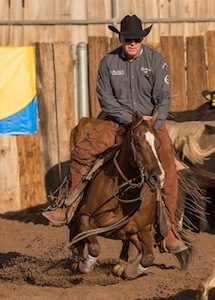Correct Position Controls the Cow in Working Cow Horse
by Al Dunning
 Working cow horse tests the agility, speed, and courage of a stock horse. In working cow horse classes, the horse must first hold the cow at one end of the arena, then run it down the fence and turn it back, and finally, circle it both ways.
Working cow horse tests the agility, speed, and courage of a stock horse. In working cow horse classes, the horse must first hold the cow at one end of the arena, then run it down the fence and turn it back, and finally, circle it both ways.
What constitutes a good ride in a working cow horse class?
A highly successful run includes your horse’s position to control the cow, the ability of the rider to read the cow properly, and a cow with speed and some respect for the horse. That’s why this class is so exciting and challenging. The event mandates you must turn the cow on the fence at least once each way. What separates the quality turns from the average or poor ones starts at the corner.
Explain the first thing the horse and rider must do after the cow enters the arena.
The class begins with the cow entering the arena and you boxing the cow. Boxing refers to holding the cow on the end of the arena, exhibiting your horse’s cow sense and agility, and preparing your horse and cow to proceed down the fence.
After boxing the cow, how do you proceed down the fence?
The wise, experienced riders approach the cow in the middle or opposite corner from the fence they will run the cow down. This allows them room to position and control the cow before the all-important corner. You should get close to the cow’s hip, what we call position 1, and drive the cow around the corner. Be sure to drive the cow past the middle marker and stay in the cow’s “bubble” enough to keep the cow on the fence.
You can understand this being a tricky spot. You don’t want the cow to hesitate at the corner, or break in front of you towards the center of the arena. Either of those scenarios will get you out of position and you will lose working advantage of the cow.
To reiterate, once the cow is running towards the opposite end of the arena, your goal is to keep the cow running on the fence past the center marker.
Explain your technique for turning the cow back.
Once the cow is running and passes the middle marker, you are ready to move up next to the cow, which we call position 2. Here you get close and parallel to the cow. In position 2 you are now rating your speed and running stride for stride with the cow.
When you are in position 2, watch the cow intently. The possibility of the cow stopping is high, as you are in the cow’s eye. I look at this as having control, in a credit-earning position. I am usually watching the back of the cow’s neck at this point because even in position 2, the cow may stop or turn.
In a few more strides, you are ready to advance forward to turn the cow. At this point, I like to sit back, watch the cow, and step by his head smoothly. If the cow doesn’t yield to your advancement, and your leg is past the cow’s shoulder, turn into the cow’s head and force the action.
A good cow will shut down and turn when you get slightly ahead of him. But with other cattle you need to be more assertive. By being close to the cow, you will get a harder turn while maintaining contact and control. This is a high quality turn. If your horse drops his shoulder and doesn’t get on his hocks in a strong stopping position, he may make a poor turn. Not allowing your horse to rate a cow in position 2, and merely charging past the cow’s head can cause a large gap between you and the cow.
How do you finish your fence work and begin to circle the cow?
After the first turn, it is imperative to “pop out” to the opposite side of the cow’s hip, now headed in the opposite direction. Get back into position 1 without losing any working advantage. Your next turn will be using the same technique without regard to the center marker because you have already satisfied that requirement on your first run. After your second turn, you must decide whether your horse and cow are prepared to circle the cow to complete your run. If not, it is more than acceptable to make additional fence turns.
Using this method and being patient, will allow your horse to understand his job doing what great cow horses do: rate and read a cow with light rein control.
A cow horse that can run hard, rate the speed smoothly, and really get on his hocks when turning is a thrill to have a leg over. A rider that focuses on staying in position will have an advantage over other competitors.
Originally Published August 2017 Issue

Al Dunning of Scottsdale, Arizona, is one of the most respected horsemen in the industry. Al and his students have garnered 48 world and reserve world championships. He has held numerous national leadership positions and earned multiple honors including induction into the AzQHA Hall of Fame. His 50+ years of experience as a professional trainer has led him to produce books, DVDs, clinics, Team AD online mentoring, and AD Tack, selling all the tack he uses as well as his books and videos. Al’s ability to reach people comes from his love of horses and out of respect to the mentors in his own life. For more information, visit https://www.aldunning.com or www.aldunningsadtack.com.

